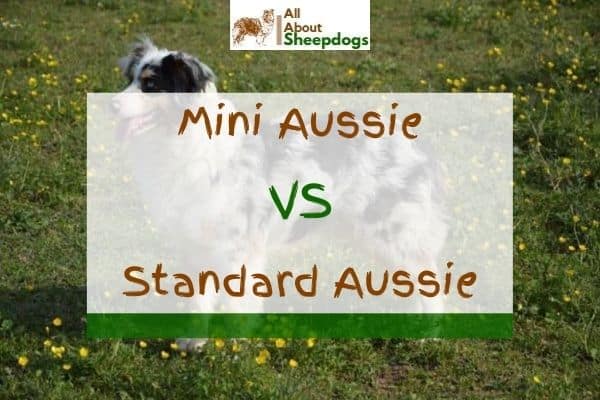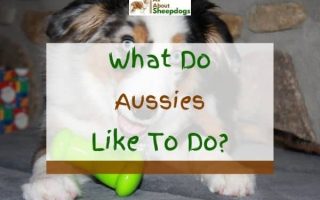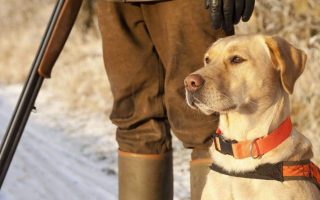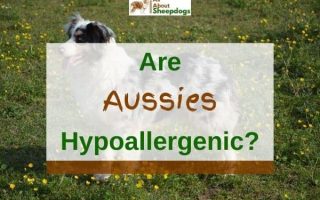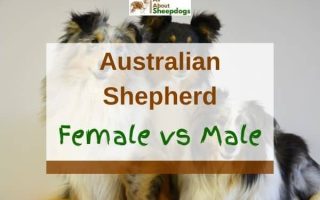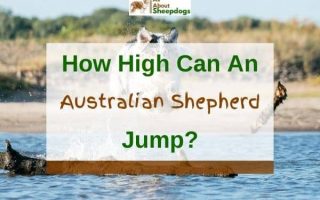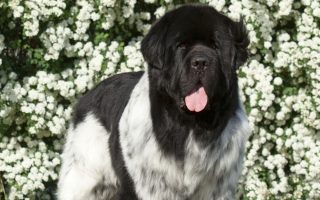Suppose you have interacted with both the Mini Australian Shepherd and the Standard Australian Shepherd.
In that case, you will agree that it can be quite difficult to pick one and leave one (if you were given such an option).
So, if you also have found yourself in such a dilemma (like I have) and you are wondering which dog to adopt between the Mini Australian Shepherd vs Standard Australian Shepherd, then worry not, as this article got you covered.
I will walk you through the history, physical appearance, lifespan, health conditions and temperament of each breed in depth.
I will also provide you with the main differences between these personality endowed dog breeds that we are optimistic will help you pick one of them as your lifetime companion.
| Attributes | Mini Australian Shepherd | Australian Shepherd |
| Good For First Time Owners | No | No |
| Good Guard Dog | No | Not The Best Chocie |
| Apartment Friendly | Yes | Possible With Enough Exercise |
| Good Family Dog | Yes | Yes |
| Shedding | Moderate | Moderate To High |
| Barking And Howling | Moderate | High |
| Height | 13-18 inches (33-46 cm) | 18-23 inches (46-58 cm) |
| Average Life Expectancy | 12-13 Years | 12-15 Years |
[wpsm_toplist]
Mini Australian Shepherd – Dog Breed Information
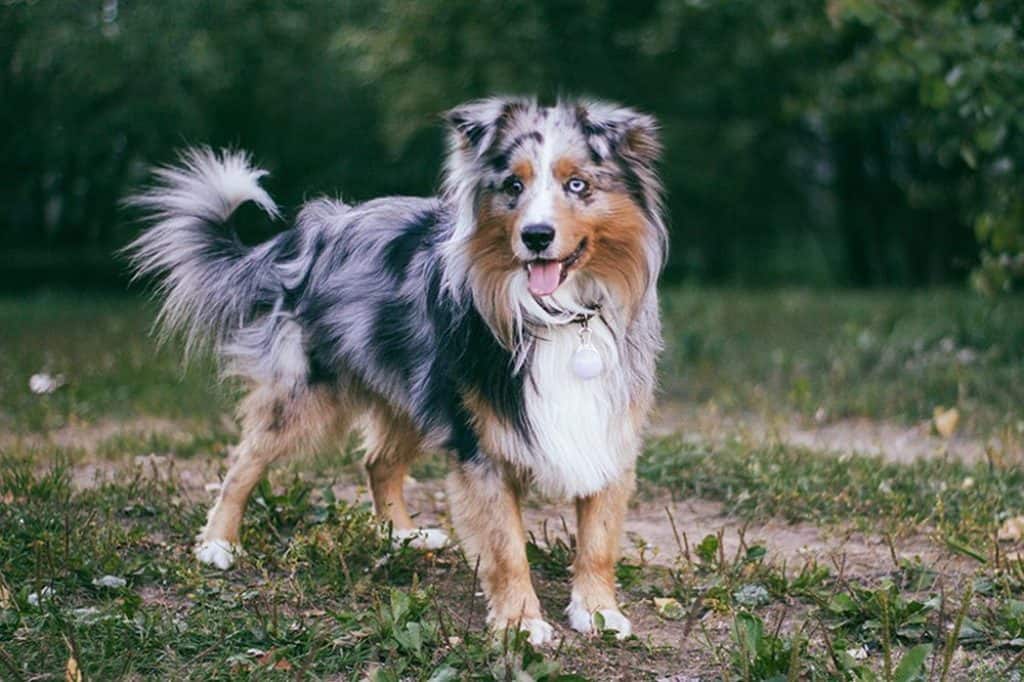
With the scientific name Canis lupus familirias, the Mini American Shepherd, also known as the Miniature Australian Shepherd, has a fascinating history that dates back to 70 years ago, as you are about to find out in this article.
History
These dogs were previously known as the Miniature Australian Shepherd dogs, until the 1990s when the middle name was changed to ‘American.’
They were developed from unregistered Australian dogs (no wonder the name) in California around the late 1960s’ to herd cattle.
The California ranchers bred these miniature dogs with the aim of preserving their energetic, independent and workaholic traits.
And this is something these breeders aced at as these miniature dog temperaments are the same as the standard Australian Shepherd dog.
These workaholic dogs were recognized and registered by the American Kennel Club (AKC) in 2011.
Physical Appearance
This adventurous dog has a medium-length double coat that is water-resistant.
The coat comes in satisfying shades of; Black tricolored, Red tricolored, blue merle or red merle.
This dog is usually longer than taller. It can grow to a height of 13-18 inches long and weigh around 20-31 pounds.
Their round heads perfectly blend with their medium-length muzzle and triangular, erect ears.
Its almond eyes may be blue, amber, hazel, or brown.
Sometimes, they can also have eyes with different colors, a normal medication condition known as Heterochromia.
PS; dogs with different eyes colors are equally healthy as those with both eyes of the same color.
They may also be born with bobbed, partially bobbed (the tail is usually stubby and mid-length) or long tails.
Lifespan And Health Problems
The MAS has an average lifespan of 12-13 years when properly fed with the right nutrition and engaged in physical exercise at a young age.
However, some hereditary medical conditions may lower their life quality and lifespan. Some of these diseases include;
- Hip dysplasia
- Degenerative myelopathy-spinal disease
- Eye conditions-cataracts and progressive retinal atrophy
Extra tip; Always adopt your Miniature American Shepherd dog from a reputable breeder to avoid getting a pup with health issues.
Regular visits to the vet will also ensure that the diseases mentioned above don’t develop into chronic conditions.
Temperament
This athletic dog breed is known for its protective nature and won’t hesitate to act up if it feels you or its ‘flock’ (maybe other pets or kids around) are threatened.
It’s also extremely outgoing, loyal, eager to please, strong-willed (especially when its needs are not met to its expectation), very energetic, alert and easy to train.
These hounds thrive on mental stimulation, so having it solve some doggy puzzles, do some tricks or play a retrieval game will sure do the trick.
NOTE! The MAS dislike being bored and will not mind chewing on things or causing tantrums if it feels mentally and physically under stimulated.
Getting this doggie another dog companion is always a good idea, but be sure that the 2 canine’s personalities complement each other.
Grooming And Maintenance
If you consider adopting this dog, you should be ready to brush their hair at least 1 or 2 times a week.
During the shedding period, which occurs at least twice in a year, these dogs will require to have their coats brushed at least 3 times a week.
Use a pin brush or any other stiff-bristled brush if you are to detangle your doggy’s hair effectively.
For the legs and neck hairs (which can be quite tricky to brush), consider using a certified shampoo with hair conditioner to make the hair soft before you start brushing it.
Giving your dog a haircut may seem fashionable to you, but it is best if you leave its coat as it is.
A once in a month bath is enough for your MAS. Remember to use a dog-safe blow dryer after bathing your doggie.
Always use the recommended dog shampoo.
Have its nails trimmed at least every 2 weeks.
Try brushing their teeth every day and gently clean their ears with a vet-certified ear cleanser.
NOTE! These dogs have sensitive ears, so if you don’t know how to groom their ears, please hire a pro and let them do it for you.
Quick Facts About The Mini Aussie
- They make good companions for city dwellers and people who like engaging in outdoor activities
- They are kid and pet friendly-they will not mind sharing space with dogs of different breeds and even cats
- They have a liter size of 2-6 puppies
- They comfortably adapt to living in small apartments-as long as you provide them with 1-hour of physical exercise preferably in an outdoor setting
- They dislike staying alone-but can stay for 1-2 hours on their own if they have been trained to do so when they are young
Standard Australian Shepherd – Dog Breed Information
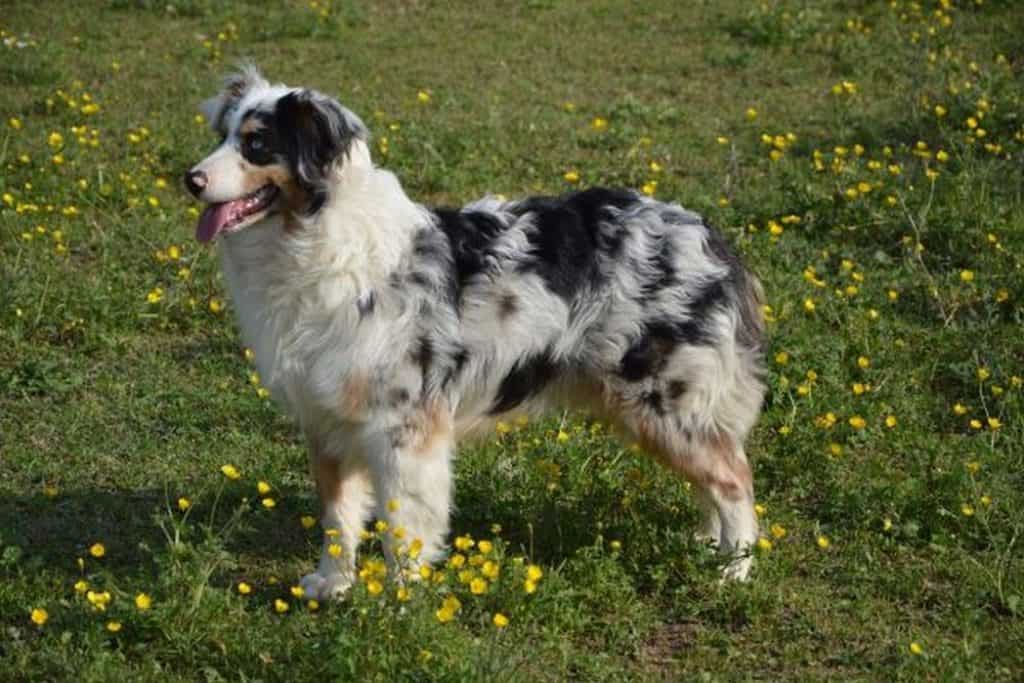
History
These dogs do not originate from Australia as the name would have you believe.
These hardy dogs’ ancestors are not accurately known.
However, some researchers suggest that they might be the descendants of the Spanish Herding dogs who were brought to the USA together with a herd of the Merino sheep in the 1800s by the Basque shepherds who were natives of Australia.
Physical Appearance
These bold dogs can grow to a height of 18-23 inches long and weigh around 35-70 pounds as adults.
They typically have a double coat which is medium in length and can be either wavy or straight in pattern.
The coat comes in a number of colors which may be; Black, blue merle, merle, red tricolor, black tricolor or red merle.
These dog breeds have almond-shaped eyes, with often being of 2 different colors.
Their ears are also triangularly shaped and stand high on a rounded head which has an equally strong, powerful muzzle that is proportional to its body size.
Lifespan And Health Problems
They have a life expectancy of 12-15 years. However, proper nutrition, adequate physical exercise and regular visits to the vet can increase their lifespan for a year or 2.
However, just like most canines, the Standard Australian dog also suffers from a number of diseases which include;
- Epilepsy
- Heart conditions
- Severe allergies
- Hip dysplasia
- Hearing and visual problems
Some of these conditions are hereditary, that is passed down from the parents, and therefore they cannot be cured but can be kept in check, thus ensuring your hound leads an almost normal dog life.
Temperament
These non-aggressive doggies tend to get along very well with kids and other pets around them.
They are also protective in nature (this trait comes from their herding instincts).
Their easy-to-train eagerness to please nature has earned them a household name among most American pet owners and lovers.
Grooming And Maintenance
This dog breed is quite a heavy shedder, thus making it necessary to brush its hair at least 4 times a week in order to avoid its hair matting (become hard to untangle hair).
Consider using waterless pH-balanced hair shampoo for convenience and ease during your dog’s hair grooming session.
Note! Do NOT overuse this type of shampoo as it may cause your dog’s hair pores to clog or lead to its hair becoming weak.
A once in a month bathe is recommended for your Australian Shepherd dog. Avoid shaving this dog as you risk disturbing its skin’s oil balance or predisposing it to get a cold.
Consider using sterile scissor clippers or guillotine clippers to trim your dog’ nails after every 1-2 weeks.
Extra tip; Have a friend help your dog calm down while you cut your pup’s nails if it is its first time.
Quick facts you should know about the Australian Shepherds before adopting one
- They are suitable for country dwellers
- They are pet and kid-friendly
- They dislike staying idle or being left alone and will mostly resort to a destructive temperament if they feel their needs (both physical and emotional) are unmet
- They have a liter size of 2-7 puppies, so in case you have a male, and a female Standard Australian Shepherd dog in your home, then be ready to be a puppy parent of more than 6 pups at once
Mini Australian Shepherd Vs Standard Australian Shepherd – What’s The Difference?
| Mini Australian Shepherd | Standard Australian Shepherd |
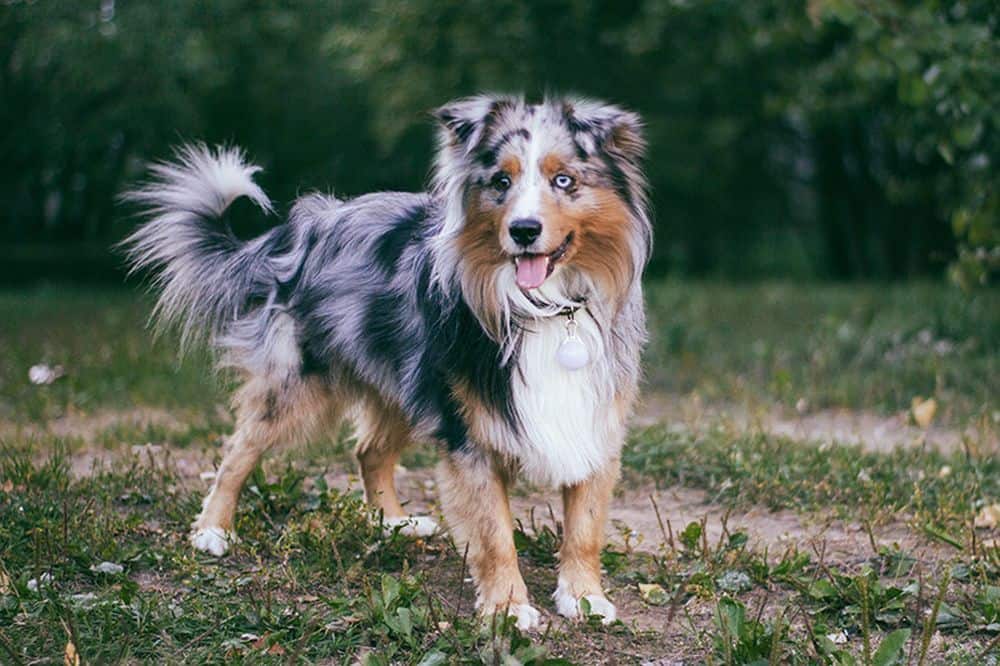 | 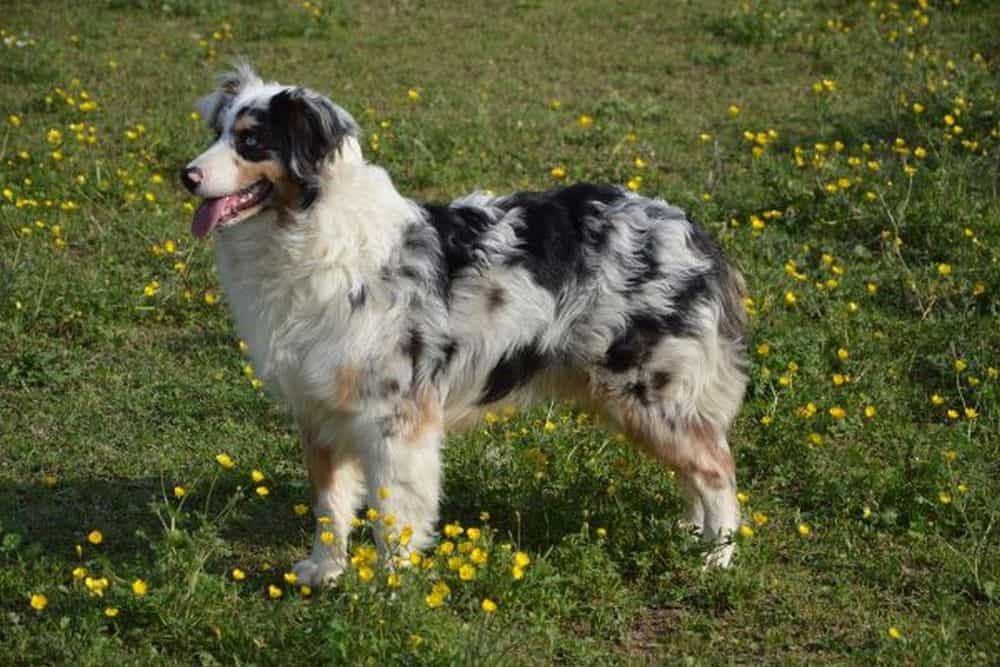 |
| Miniature American Shepherd by TanSinVic (CC BY-SA 4.0) |
Below are some of the differences that distinguish the Miniature Australian shepherd from the Standard Australian shepherd:
Shedding And Grooming
The Mini Australian Shepherd sheds less of its fur when compared to the Standard Australian Shepherd
The Mini Aussie requires less time to groom, unlike the Australian Shepherd, who may need much longer time to adequately groom due to its fur amount and size
Living Environment And Space Required
The Mini Aussies will comfortably adopt to living in small indoor setup or space, unlike the Standard Australian shepherd who can hardly cope living indoors and will require large indoor and outdoor space to accommodate its hyperactive nature
The Mini Aussie is perfect for city dwellers, whereas the Standard Aussies are a good fit for country dwellers
Barking Tendency
The Mini Aussies don’t bark a lot unless it is to warn you that there is some threat or emergency.
On the other hand, the Standard Australian Shepherd ‘Barks’ a lot, even for no reason.
However, you can train this hound to bark when necessary; just be sure to do it when it’s still young
Size
The Mini Aussie can grow to a height of 13-18 inches long, whereas the Standard Australian Shepherd can grow to 18-23 inches long.
The males are usually larger than the females in both breeds
Drooling
The Miniature Aussie tends to drool more than the Standard Australian Shepherd dog
Lifespan
The life expectancy of a Mini Aussie is 12-13 years, while the lifespan of the Standard Australian Shepherd is 12-15 years.
This means that the Mini Aussie has a shorter life expectancy when compared to its cousin
Hyperactivity
Despite these 2 dog breeds requiring the same amount of exercise, the Standard Australian Shepherd tends to be more hyperactive when it’s compared to its miniature cousin, who is most of the time calm after its exercising routine
Mini Australian Shepherd Vs Standard Australian Shepherd – Which One Is Best For You?
Both the Mini Australian Shepherd Vs Standard Australian Shepherd make good dog companions.
They both have double coats, they are both kid and pet friendly, affectionate and outgoing, and they both don’t tolerate being left alone for long hours.
The Mini Aussie has a shorter life expectancy, tends to drool more, and it’s also less hyperactive than its standard Australian Shepherd dog cousin.
The Standard Australian Shepherd dog sheds more heavily than its miniature Aussie, barks a lot, and needs a large outdoor space to put its high energy into use.
If you notice your Mini or Standard Aussie has started developing aggressive behavior, it is highly recommended that you get it another dog for companion or have an animal behaviorist specialist help you handle the situation like a pro.
Since both these dogs make excellent pets and lifetime companions, it is important that you carefully evaluate your lifestyle and personal preferences before you adopt any of them.
Please ensure that you adopt your doggie from a reputable breeder to avoid getting a dog that has low-quality genetic makeup!
Always take your Aussies to regular vet checkups to enhance their life expectancy.

